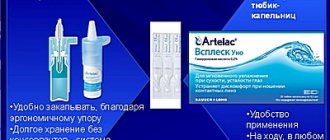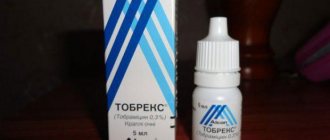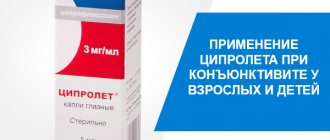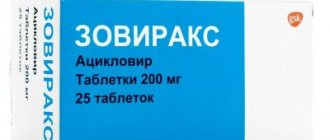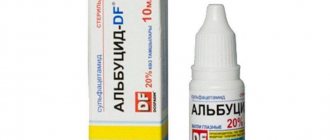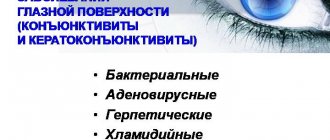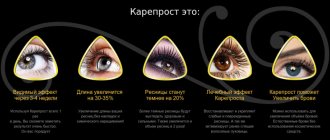Release form and description
Albucid is available in eye drop format. The bottle is made of plastic. It can have a volume of 5 or 10 ml.
The concentration of the active substance also differs - it is 20% or 30% of the total volume of the solution.
The main active ingredient of the drug is sulfacetamide. The composition also includes: purified water, sodium thiosulfate and hydrochloric acid.
The drug has an antimicrobial effect . Its components dissolve freely in water and penetrate into organ tissues. Sulfacetamide prevents bacterial growth. Thanks to this, the disease does not progress.
The solution is effective against the following types of bacteria:
- gonococci;
- coli;
- chlamydia;
- streptococci;
- staphylococci.
Note to parents: is Tantum Verde suitable for children under one year of age? Recommendations from pediatricians are in this article.
We provide instructions for using the drug IRS 19 for children in our material.
If you want to know how many days to take Flemoxin Solutab for a child, read this publication.
Instructions for use
The insert is enclosed in a cardboard package with drops. It describes in detail the effect of the drug, recommended dosages, side effects and contraindications. The individual dosage and duration of treatment is determined by the doctor, taking into account the specifics of the disease. The manifestation of side effects or lack of therapeutic effect 3-4 days after administration requires discontinuation of the drug, repeated consultation and replacement of the drug.
For adults
The drug is prescribed only locally. Before instillation, the bottle with drops should be warmed in your hands, and then washed with soap. For instillation, the patient throws his head back or lies on his back. The tip of the bottle should not touch the mucous membrane, eyelashes or eyelids. Carefully, pulling back the lower eyelid with one hand, instill the required number of drops into the resulting pocket. After the procedure, you can close your eyes for a few seconds.
If it is necessary to use several types of drops, the break should be at least 20 minutes.
For newborns and children
Albucid is approved for use in children from the first days of life. It is prescribed for the prevention of blenorrhea immediately after birth. In addition, eye drops for children can be used in the ear or nose when infectious and inflammatory diseases of these structures develop. The selection of dosage and duration of treatment is determined by the pediatrician, taking into account the age of the baby and the nature of the pathological process.
Read more Instructions for using Ujala eye drops
During pregnancy and lactation
Albucid eye drops are approved for use during breastfeeding and pregnancy. The only contraindication is episodes of an allergic reaction in a pregnant or lactating woman to sulfonamides.
Purpose
Albucid is prescribed for the treatment and prevention of eye diseases . But sometimes doctors prescribe the medicine to be instilled into the child’s nasal cavity.
It is possible to use the drug from birth. It is often prescribed to infants for preventive purposes.
Albucid for children is indicated for the following diseases:
- from conjunctivitis;
- corneal ulcers;
- blepharitis;
- keratitis;
- runny nose.
Drops are not prescribed for the treatment of viral or allergic diseases. They are focused on combating certain types of bacteria.
After using the drug, swelling decreases, purulent formations disappear, and redness of the eyes subsides. Itching and burning in the cornea and ciliary space are reduced.
The instructions for the drug do not contain information about the possibility of using it to treat a runny nose. Sometimes doctors prescribe Albucid to eliminate diseases of bacterial origin.
If your runny nose is viral in nature, these drops will not help.
The main difference between a bacterial runny nose is the characteristic thick green discharge from the nasal cavity.
Contraindications for use
"Albucid" is intended to eliminate inflammatory eye pathologies in children from birth. But it is necessary to take into account contraindications, which are clearly stated in the instructions:
- hypersensitivity to any components included in the product;
- simultaneous use with medications based on purified silver.
There are no other contraindications, but you should carefully monitor the child’s reaction and, if there are unpleasant symptoms, immediately show the baby to a doctor.
Contraindications
Albucid cannot be used if you are allergic to one of the components of the composition.
Otherwise, the likelihood of discomfort will increase. It manifests itself as burning and redness in the eye area.
Rashes may form on the body. Along with this, dizziness and headache develop.
In other cases, the use of drops does not pose any danger. Most children tolerate the drug without problems.
Difficulties can arise only with the instillation process itself.
Efficiency level
The effect of Albucid is based on inhibiting the process of reproduction of pathogenic microbes. It prevents the appearance of new ones and eliminates old ones.
When used prophylactically, the risk of developing certain ophthalmological diseases is reduced. Therefore, Albucid is instilled into newborn children.
When treating a runny nose, the effect of the drug will appear after some time. If you have eye diseases, improvement will be noticeable after the first instillation.
Tearfulness will gradually disappear and the amount of purulent discharge will decrease. Complete relief from the disease will occur 7-10 days after starting treatment.
Can Albucid be given to newborns?
The use of Albucid in newborns is permitted, but it is not recommended to use drops for more than 10 days.
Indications for Albucid eye drops in children
Indications for the appointment of Albucid are infectious and inflammatory diseases of the anterior segment and adnexa of the eye, which include:
- blepharitis;
- conjunctivitis;
- dacryocystitis;
- keratitis.
In addition to the treatment of infectious diseases, Albucid in newborns is used to prevent blenorrhea.
Dosage
For children, a solution is provided in a 20% dosage. The dosage of the drug is prescribed by the ophthalmologist , taking into account the severity of the symptoms.
To treat bacterial rhinitis, a dosage regimen is prescribed. It is necessary to instill 1-2 drops of the medicine into each nasal passage. The procedure is carried out three times a day.
For prevention, one drop of the product is instilled into the eyes, up to three times a day.
In the presence of an inflammatory process, the number of instillations can reach 6 times a day.
Description of the drug
Albucid is an antimicrobial drug based on sulfacetamide. The medicine penetrates well into all membranes of the eye and stops the proliferation of bacteria from groups such as gonococci, streptococci, staphylococci, and E. coli. Available in plastic bottles with a convenient dropper, so no instillation equipment is required. The contents of the bottles may have different concentrations - 20% and 30%. For newborns, a lower concentration is used, and if necessary, the drug can be diluted with boiled water.
Albucid is one of the most popular and cheapest solutions that are successfully used to treat bacterial and infectious eye infections.
Albucid for newborns is a drug that is prescribed not only for the treatment of eye diseases, it is also a good remedy for the prevention of certain infections. Often, the first instillation occurs in the maternity hospital to eliminate the possibility of infection of the children’s eyes with blenorrhea. During the birth process, the baby becomes infected with this infection through the genital tract of the woman in labor. If gonococci were found in the blood of a pregnant woman before birth, then the newborn must be inoculated immediately after birth. If the process of bacterial reproduction is not stopped, there is a high probability that the child will develop blenorrhea, which without proper treatment can lead to blindness.
How and how much to drip into a child’s eyes and nose
The Albucid bottle is equipped with a special dropper so that the product can be dosed.
It is more convenient to use the drops in a vertical position. You need to ask the child to look up. Drops are instilled into the lower fornix of the conjunctival sac.
To instill Albucid into the nose, tilt the child's head back.
How many drops of Albucid should be dripped into a child’s nose? 1-2 drops are instilled into each nostril. Excess is removed with a paper towel or handkerchief.
The nature of interaction with other drugs
Albucid can be combined with most medications , especially as part of complex treatment. But you should remember the limitations.
Eye drops containing antibiotics and silver-based medications are not compatible with Albucid.
The possibility of combining drugs for complex therapy is clarified by the pediatrician.
For example, Tetracaine reduces the antiseptic effect of Albucid on the body when used simultaneously.
Mechanism of action
The drug quickly penetrates the mucous tissues of the eyes and binds to the cells of pathogenic bacteria. At the same time, the process of stopping their development and reproduction occurs. The effectiveness of the drug in the fight against pathologies that were caused by:
- staphylococci;
- streptococci;
- chlamydia.
The main mechanism of therapeutic action is the suppression of the production of cells that are necessary for the development and reproduction of pathogenic bacteria. As a result, the vital activity of microorganisms cannot remain at the proper level and they die in a minimum period of time.
Side effects
Any eye drops act as an irritant to the cornea of the eye. Tearfulness is a normal reaction to the instillation process.
There may be a slight burning sensation and discomfort for some time. Soon the discomfort goes away. Along with them, the signs of the disease also decrease.
Normally, side effects should disappear over time. If this does not happen, then we may be talking about an allergic reaction .
If this occurs, you should immediately stop using the drug.
If you don’t know how to give Amoxicillin tablets to children, read our publication.
Instructions for use of children's Acipol are presented for review in this article.
How is Miramistin used for herpes sore throat in children? Find the answer to your question here.
Contraindications and side effects
The drug is contraindicated in children who have individual sensitivity or intolerance to the active substance. If a child has a history of allergies to sulfonamides (antimicrobial agents), then Albucid is not prescribed.
Frequent side effects that occur in children are local allergic reactions:
- itching, dryness, redness of the mucous membrane;
- burning, tingling, discomfort in the eyes;
- swelling;
- peeling of the skin in the eyelid area.
Nonspecific conjunctivitis and anaphylactic reactions are diagnosed. Sometimes a secondary infection (viral, fungal) develops.
The drug can cause more severe consequences:
- aplastic anemia ─ anemia with a sharp decrease in general immunity, a violation of the blood clotting mechanism;
- agranulocytosis ─ decreased leukocyte levels, increased susceptibility to fungal and bacterial infections;
- fulminant liver necrosis (mass death of hepatocytes);
- toxic epidermal necrosis ─ allergic bullous dermatitis.
In case of overdose, side effects appear in the form of local reactions.
Price in the Russian Federation and holiday conditions, analogues
The cost of the medicine depends on the volume of the bottle. The price of the drug is affected by the region of residence.
The average price of drops in a 5 ml bottle within the Russian Federation is approximately 65 rubles. A 10 ml package costs more - approximately 80 rubles.
The expiration date of the drug is indicated on the packaging. Once opened, it is good for 1 month. The bottle with the product should be stored in a dark place at a temperature no higher than 25 degrees.
Dispensed in pharmacies without a doctor's prescription.
Medications with similar effects include Oftaquix, Tobrex and Levomycetin.
Reviews
- Elena: “I really like the drug for its effectiveness. The only drawback for me personally is the inconvenient packaging. Previously it had a lid. It’s no longer available in the new format.”
- Alena: “I try to make sure that the drops are in the home medicine cabinet. The child often rubs his eyes, which facilitates the penetration of bacteria. Even with slight redness, I put drops in – and everything goes away.”
- Julia: “Multifunctional product! They gave it to a three-month-old baby - both for a runny nose and for inflammation of the eyes. The drug coped with both problems. And it’s inexpensive.”
- Maria: “I used Albucid several times. The first time I used it to treat my son’s conjunctivitis. The drug helped quickly. The second time it was possible to stop barley at an early stage of its appearance. The disadvantages include the short shelf life after opening.”
Pediatricians approve of the use of the drug both for serious diseases and for preventive purposes.
Despite the presence of analogues, Albucid is still popular in pediatric practice and is liked by parents.
How to bury children correctly
Sulfacyl sodium is the official name of the medicinal substance.
The drug belongs to the group of sulfonamides and has an antimicrobial effect, but is not an antibiotic. Sulfonamides have a different mechanism of action. When pathogenic microorganisms get into a child's eyes, it causes inflammation of the mucous membrane - bacterial conjunctivitis and other eye diseases. For treatment to be effective, the exact dosage must be observed. The procedure for instilling eye drops in children is different, which is associated with restless behavior and fear of manipulation.
To apply eye drops to a preschool child, an adult sits him on his knees, holds his body with one hand, and his head with the other. After this, a medical worker (if the patient is in a hospital) or a parent (if the baby is undergoing outpatient treatment) instills the drops. In this case, the child’s head should be slightly tilted back, the lower eyelid pulled outward.
Features of the procedure in newborns and infants:
- Prepare eye drops and sterile cotton swabs.
- Place the baby on the changing table.
- If there are crusts or pus on the mucous membrane or eyelids, rinse the conjunctiva with boiled water and furatsilin solution before instilling the medicine. Take a separate sterile swab for each eye.
- Take a dropper bottle with Albucid and hold it in your palm for 30-60 seconds so that the solution warms up.
- Place your right hand with the bottle on the child’s forehead. This will fix the head and reduce the risk of mechanical damage to the eyeball from the dropper tip.
- Apply the solution at an angle of 40°, this will avoid injury. Do not touch the tip to the mucous membrane and skin of the eyelids.
- Use a dry cotton swab to pull back the lower eyelid and release 1 drop from the bottle into the resulting “pocket.”
